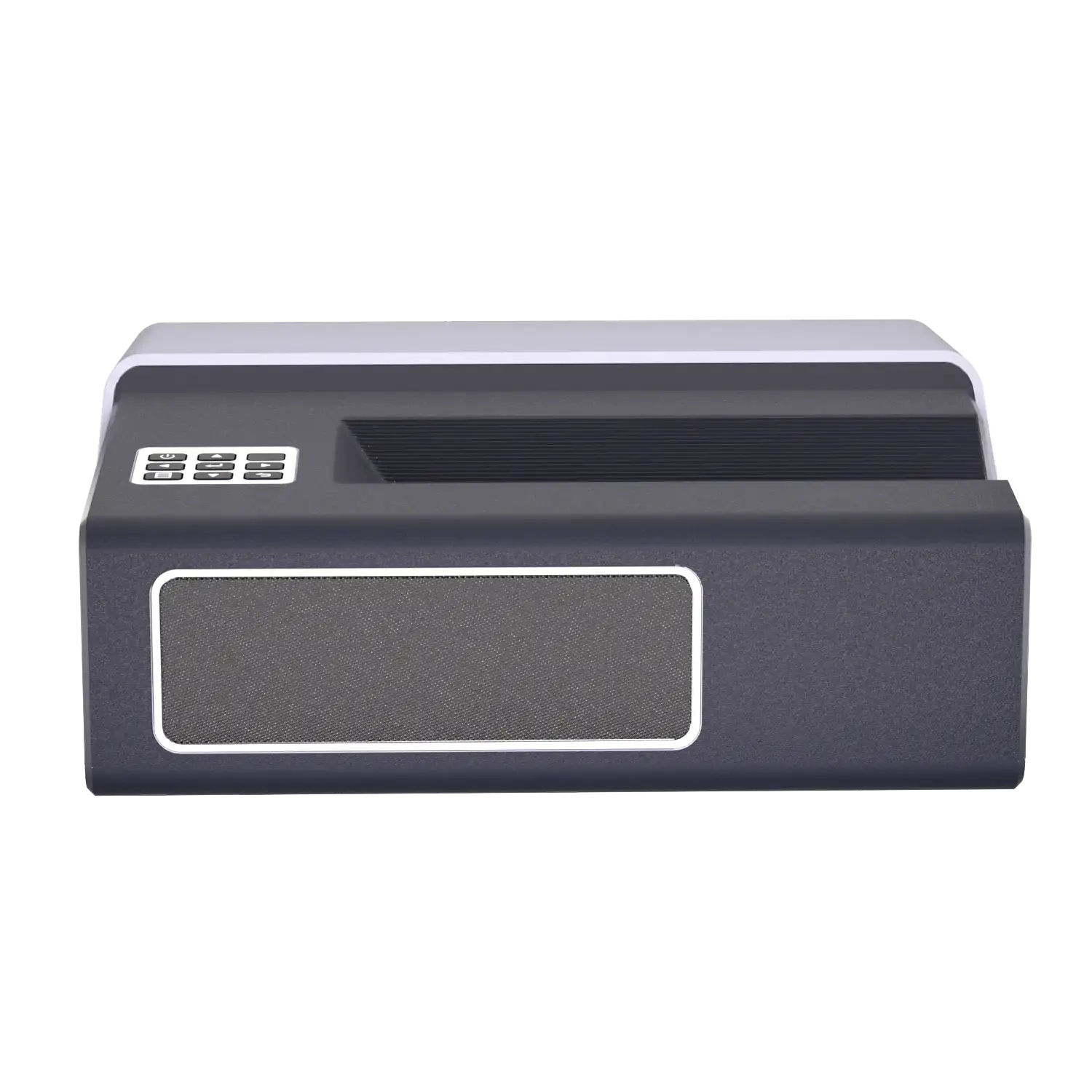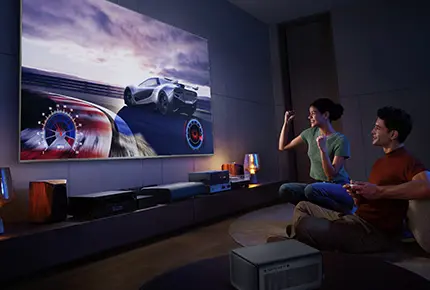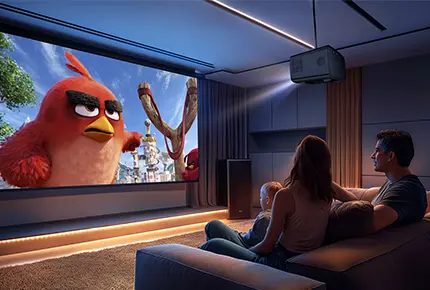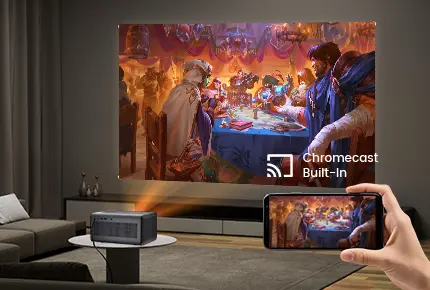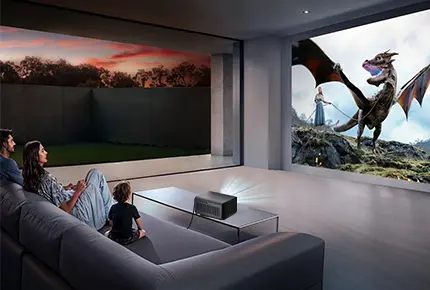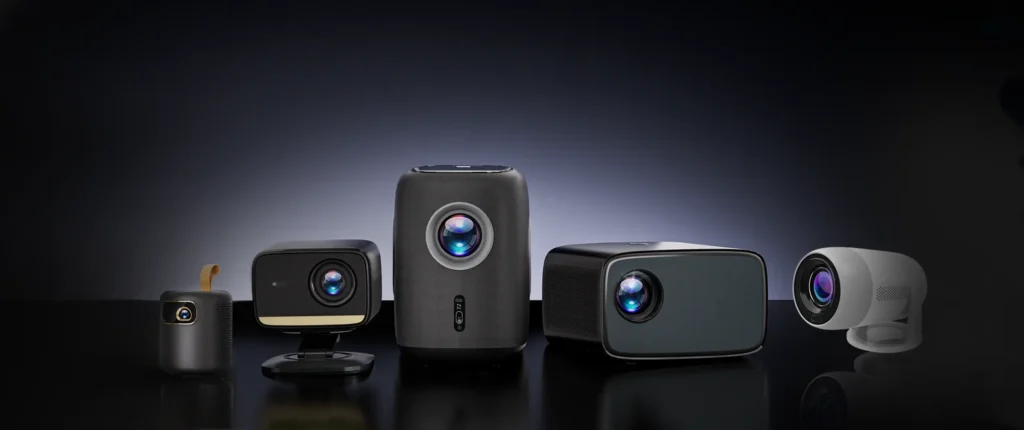
A short throw projector is a projection device with an extremely low throw ratio (typically 0.27–0.69), capable of projecting a 70–120-inch image from a distance of tens of centimeters to 1.5 meters, significantly improving space utilization. Its core goal is to solve the issues of light obstruction and installation space limitations in traditional projectors by shortening the projection distance, making it suitable for education, business, home, and other scenarios.
Core Technology of Short Throw Projector
Short throw technology is primarily achieved through two optical solutions:
Fisheye Lens (Refractive Type):
Principle: Uses an ultra-wide-angle lens (similar to a camera fisheye lens) with complex lens groups to refract light directly, shortening the optical path.
Features: Relatively simple structure and lower cost but prone to linear distortion (image edge deformation), requiring algorithmic correction.
Reflective Optical System:
Principle: Light is first projected onto a reflector, then reflected to the screen, compressing the optical path using precision components like aspherical mirrors or free-form mirrors.
Features: Shorter projection distance (e.g., 47cm for 60 inches) but demands high manufacturing precision; minor mirror errors cause uneven brightness or deformation.
Auxiliary Technological Breakthroughs:
Digital Micromirror Device (DMD): Core of DLP technology, precisely controls light reflection via micromirror arrays to enhance image quality and response speed.
Distortion Correction Algorithms: Real-time correction of geometric distortion caused by fisheye lenses, ensuring a flat image.
High-Precision Optical Materials: Aspherical lenses and low-dispersion materials reduce aberrations and improve color accuracy.
What is an UST (ultra short throw) projector?
An ultra short throw projector is a device that achieves extremely short-distance projection through specialized optical designs. Its key parameter is the throw ratio (≤0.4), meaning it can project an image larger than 80 inches from just a few tens of centimeters away. For example, a 100-inch image typically requires only 25 to 50 cm of distance.
Throw Ratio = Projection Distance / Image Width
Throw Ratio Classifications
Long Throw Projector: Throw ratio 1.0–1.9 → Projects 100 inches from 2.5–3 meters
Short Throw Projector: Throw ratio 0.4–1.0 → Projects 100 inches from 1–2 meters
Ultra Short Throw (UST) Projector: Throw ratio ≤ 0.4 → Projects 100 inches from <0.5 meters
UST projectors typically use a reflective optical system, in which light is redirected by free-form or aspheric mirrors to fold the optical path, drastically reducing physical distance.
Explore Koonew’s UST High Brightness 4K Laser Projector: HD50V
Short Throw vs. Long Throw Projectors: Pros and Cons
Short Throw Projector Advantages
Space Adaptability: Projects 100-inch screens from near-wall distances (e.g., 0.34m for 100 inches), ideal for small spaces and meeting rooms.
Avoids Interference: Proximity to the screen prevents presenters from blocking light or casting shadows, protecting eyes from direct glare.
Easy Installation: No ceiling mounting required; desktop placement suffices, supporting flexible mobility.
Audio-Visual Synchronization: Sound and image are emitted from the same direction, enhancing immersion (long throw projectors separate audio and visuals).
Short Throw Projector Disadvantages
Lower Brightness: Optical path compression causes brightness loss; most models <3000 lumens, underperforming in bright environments vs. long throw.
Edge Distortion: Fisheye lenses rely on algorithmic correction; low-end models may show uneven images.
Cost and Size: Complex optics increase price (20–30% higher than equivalent long throw) and result in bulkier bodies.
Size Cap: Typically maxes at 120 inches; long throw easily exceeds 150 inches.
Long Throw Projector Advantages
Image Quality Priority: Higher brightness (5000+ lumens), more accurate colors, suitable for demanding scenarios (e.g., home theaters).
Projection Flexibility: Supports large screens at long distances (e.g., 10m for 150 inches), ideal for large venues.
Price Advantage: Mature technology offers lower prices for similar brightness
Long Throw Projector Disadvantages
Larger Space Required: Long throw projectors typically require a greater distance to project large images, which can be restrictive in smaller spaces. For example, projecting a 100-inch image generally requires a distance of 2.5–3 meters.
Sufficient depth must be reserved, resulting in lower space utilization.
Fixed Installation: Most long throw projectors—especially commercial and engineering models—require fixed ceiling mounting and involve complex setup and calibration processes.
Light Obstruction and Interference: Due to the long light path, people walking by or objects passing through can block the beam, casting shadows on the screen.
Additionally, projectors are usually positioned behind the audience, and the strong light may directly shine into their eyes.
Video and Audio Out of Sync: Without external speakers, the distance between the projector and the viewing area can cause audio and video to feel out of sync, reducing the immersive experience.
Applications of Short Throw Projectors
Education Sector
Pain Point Solved: Teachers no longer block light or suffer glare; projectors mount close to whiteboards (e.g., 1m for 80 inches with 0.6 throw ratio).
Interactive Teaching: Integrates with smart boards for touch annotations.
Business Meetings
Small Conference Rooms: 1m for 100 inches, solving space constraints in SMEs.
Efficient Demos: No setup needed; supports wireless casting for faster meetings.
Home Entertainment
Compact Home Theaters: Wall-projected 100-inch screens replace TVs.
Gaming Experience: Players near screens avoid shadow interference, ideal for motion-sensing games.
Commercial Displays
Window Advertising: Short-distance projections attract attention, boosting store traffic.
Exhibition Interaction: Combines with AR for wall-based interactive displays.
Koonew’s Education & Business Short Throw Projector: WX50X

